Hydrothermal Treatment of Sewage Sludge Under Different Process Conditions with a Focus on Energy Properties and Resource Recovery
Abstract
1. Introduction
2. Materials and Methods
2.1. Material
2.2. Hydrothermal Carbonization
2.3. Analytical Methods
3. Results and Discussion
3.1. Hydrochar
3.2. Liquid Fraction
4. Conclusions
5. Prospects
Author Contributions
Funding
Data Availability Statement
Acknowledgments
Conflicts of Interest
References
- Sun, X.; Liu, B.; Zhang, L.; Aketagawa, K.; Xue, B.; Ren, Y.; Bai, J.; Zhan, Y.; Chen, S.; Dong, B. Partial Ozonation of Returned Sludge via High-Concentration Ozone to Reduce Excess Sludge Production: A Pilot Study. Sci. Total Environ. 2022, 807, 150773. [Google Scholar] [CrossRef]
- Zhen, K.; Zhu, Q.; Zhai, S.; Gao, Y.; Cao, H.; Tang, X.; Wang, C.; Li, J.; Tian, L.; Sun, H. PPCPs and Heavy Metals from Hydrothermal Sewage Sludge-Derived Biochar: Migration in Wheat and Physiological Response. Environ. Sci. Pollut. Res. 2022, 29, 83234–83246. [Google Scholar] [CrossRef]
- Shaddel, S.; Bakhtiary-Davijany, H.; Kabbe, C.; Dadgar, F.; Østerhus, S. Sustainable Sewage Sludge Management: From Current Practices to Emerging Nutrient Recovery Technologies. Sustainability 2019, 11, 3435. [Google Scholar] [CrossRef]
- Halkos, G.; Gkampoura, E.-C. Where Do We Stand on the 17 Sustainable Development Goals? An Overview on Progress. Econ. Anal. Policy 2021, 70, 94–122. [Google Scholar] [CrossRef]
- Sharma, P.; Pandey, A.K.; Udayan, A.; Kumar, S. Role of Microbial Community and Metal-Binding Proteins in Phytoremediation of Heavy Metals from Industrial Wastewater. Bioresour. Technol. 2021, 326, 124750. [Google Scholar] [CrossRef]
- Kacprzak, M. Sewage Sludge as a Source of Organic to Be Used as Soil Improvement. In Water Management and Circular Economy; Elsevier: Amsterdam, The Netherlands, 2023; pp. 303–316. [Google Scholar]
- Ayub, M.A.; Adnan, M.; Umar, W.; Farooqi, Z.U.R.; Awais, M.; Ahmad, H.R.; Imran Ch, B.; Siddique, A. Required Quality of Sewage Sludge as an Agricultural Soil Amendment. In Sustainable Management and Utilization of Sewage Sludge; Springer International Publishing: Cham, Switzerland, 2022; pp. 247–262. [Google Scholar]
- Ammar, E.; Maury, H.; Morin, L.; Sghir, A. Environmental, Economic, and Ethical Assessment of the Treated Wastewater and Sewage Sludge Valorization in Agriculture. In Interaction and Fate of Pharmaceuticals in Soil-Crop Systems; Springer: Cham, Switzerland, 2020; pp. 49–78. [Google Scholar]
- Raza, T.; Ali, I.; Khan, N.; Eash, N.S.; Qadir, M.F.; Jatav, H.S. Detoxification of Sewage Sludge by Natural Attenuation and Application as a Fertilizer. In Environmental Pollution Impact on Plants; Apple Academic Press: New York, NY, USA, 2023; pp. 245–270. [Google Scholar]
- Zorpas, A.A.; Arapoglou, D.; Panagiotis, K. Waste Paper and Clinoptilolite as a Bulking Material with Dewatered Anaerobically Stabilized Primary Sewage Sludge (DASPSS) for Compost Production. Waste Manag. 2003, 23, 27–35. [Google Scholar] [CrossRef]
- Wang, L.; Chang, Y.; Li, A. Hydrothermal Carbonization for Energy-Efficient Processing of Sewage Sludge: A Review. Renew. Sustain. Energy Rev. 2019, 108, 423–440. [Google Scholar] [CrossRef]
- Zhang, X.; Li, X.; Li, R.; Wu, Y. Hydrothermal Carbonization and Liquefaction of Sludge for Harmless and Resource Purposes: A Review. Energy Fuels 2020, 34, 13268–13290. [Google Scholar] [CrossRef]
- Roslan, S.Z.; Zainudin, S.F.; Mohd Aris, A.; Chin, K.B.; Musa, M.; Mohamad Daud, A.R.; Syed Hassan, S.S.A. Hydrothermal Carbonization of Sewage Sludge into Solid Biofuel: Influences of Process Conditions on the Energetic Properties of Hydrochar. Energies 2023, 16, 2483. [Google Scholar] [CrossRef]
- Wilk, M.; Czerwińska, K.; Śliz, M.; Imbierowicz, M. Hydrothermal Carbonization of Sewage Sludge: Hydrochar Properties and Processing Water Treatment by Distillation and Wet Oxidation. Energy Rep. 2023, 9, 39–58. [Google Scholar] [CrossRef]
- Villamil, J.A.; De la Rubia, M.A.; Diaz, E.; Mohedano, A.F. Technologies for Wastewater Sludge Utilization and Energy Production: Hydrothermal Carbonization of Lignocellulosic Biomass and Sewage Sludge. In Wastewater Treatment Residues as Resources for Biorefinery Products and Biofuels; Elsevier: Amsterdam, The Netherlands, 2020; pp. 133–153. [Google Scholar]
- Maniscalco, M.P.; Volpe, M.; Messineo, A. Hydrothermal Carbonization as a Valuable Tool for Energy and Environmental Applications: A Review. Energies 2020, 13, 4098. [Google Scholar] [CrossRef]
- Zhang, Z.; Yan, T.; Zhang, T.; Zhang, Z.; Wang, W.; Peng, H.; Li, D.; Zhu, Z. Volatile Fatty Acid Release and Metal Ion Concentration in Hydrothermal Carbonization Liquid. J. Anal. Appl. Pyrolysis 2024, 183, 106815. [Google Scholar] [CrossRef]
- Czerwińska, K.; Śliz, M.; Wilk, M. Thermal Disposal of Post-Processing Water Derived from the Hydrothermal Carbonization Process of Sewage Sludge. Waste Biomass Valorization 2023, 15, 1671–1680. [Google Scholar] [CrossRef]
- Liu, G.; Xu, Q.; Abou-Elwafa, S.F.; Alshehri, M.A.; Zhang, T. Hydrothermal Carbonization Technology for Wastewater Treatment under the “Dual Carbon” Goals: Current Status, Trends, and Challenges. Water 2024, 16, 1749. [Google Scholar] [CrossRef]
- Durán-Valle, C.J.; Botet-Jiménez, A.B.; Omenat-Morán, D. Hydrothermal Carbonisation: An Eco-Friendly Method for the Production of Carbon Adsorbents. In Adsorption Processes for Water Treatment and Purification; Springer International Publishing: Cham, Switzerland, 2017; pp. 77–108. [Google Scholar]
- Czerwińska, K.; Wierońska-Wiśniewska, F.; Bytnar, K.; Mikusińska, J.; Śliz, M.; Wilk, M. The Effect of an Acidic Environment during the Hydrothermal Carbonization of Sewage Sludge on Solid and Liquid Products: The Fate of Heavy Metals, Phosphorus and Other Compounds. J. Environ. Manag. 2024, 365, 121637. [Google Scholar] [CrossRef]
- Czerwińska, K.; Mikusińska, J.; Błoniarz, A.; Śliz, M.; Wilk, M. The Effect of Residence Time during the Hydrothermal Carbonization Process of Sewage Sludge on the Properties of Hydrochar. Energies 2024, 17, 3380. [Google Scholar] [CrossRef]
- ASTM D7582; Standard Test Methods for Proximate Analysis of Coal and Coke by Macro Thermogravimetric Analysis. ASTM International: West Conshohocken, PA, USA, 2023.
- ISO 17246:2010; Coal—Proximate Analysis to Determine Moisture (M), Ash (Ash) and Volatile Matter (VM) Contents. The Ultimate Analysis (Carbon (C), Nitrogen (N), Hydrogen (H), and Sulphur (S) Contents. ISO: Geneva, Switzerland, 2010.
- Polish Committee for Standardization. PKN ISO/TS 12902: 2007; Solid Mineral Fuels—Determination of Total Carbon, Hydrogen and Nitrogen—Instrumental Methods. Polish Committee for Standardization: Warsaw, Poland, 2013.
- Channiwala, S.A.; Parikh, P.P. A Unified Correlation for Estimating HHV of Solid, Liquid and Gaseous Fuels. Fuel 2002, 81, 1051–1063. [Google Scholar] [CrossRef]
- U.S. Environmental Protection Agency. Methodology for Thermal Efficiency and Energy Input Calculations and Analysis of Biomass Cogeneration Unit Characteristics; U.S. Environmental Protection Agency: Washington, DC, USA, 2007. [Google Scholar]
- ISO 23697; Water Quality—Determination of Total Bound Nitrogen (ST-TNb) in Water Using Small-Scale Sealed Tubes. ISO: Geneva, Switzerland, 2010.
- ISO 11905-1:1997; Water Quality—Determination of Nitrogen Part 1: Method Using Oxidative Digestion with Peroxodisulfate. ISO: Geneva, Switzerland, 2010.
- DIN 38405-9; German Standard Methods for Examination of Water, Waste Water and Sludge-Anions (Group D)—Part 9: Spectrometric Determination of Nitrate (D 9). DIN: Berlin, Germany, 2011.
- EPA 365.2+3; Hosphorous, All Forms (Colorimetric, Ascorbic Acid, Two Reagent). EPA: Washington, DC, USA, 1978.
- APHA Method 4500-P; Standard Methods for the Examination of Water and Wastewater. American Public Health Association: Washington, DC, USA, 1992.
- ISO 6878:2004; Water Quality—Determination of Phosphorus—Ammonium Molybdate Spectrometric Method. ISO: Geneva, Switzerland, 2010.
- O’Dell, J.W. (Ed.) EPA Method 410.4, Revision 2.0: The Determination of Chemical Oxygen Demand by SemiAutomated Colorimetry; EPA: Washington, DC, USA, 1993. [Google Scholar]
- American Public Health Association. APHA 5220 Chemical Oxygen Demand; American Public Health Association: Washington, DC, USA, 1997. [Google Scholar]
- ASTM D1252-06; Standard Test Methods for Chemical Oxygen Demand (Dichromate Oxygen Demand) of Water. ASTM: West Conshohocken, PA, USA, 2012.
- Wilk, M.; Śliz, M.; Czerwińska, K.; Śledź, M. The Effect of an Acid Catalyst on the Hydrothermal Carbonization of Sewage Sludge. J. Environ. Manag. 2023, 345, 118820. [Google Scholar] [CrossRef]
- Feng, Y.; Yu, T.; Ma, K.; Xu, G.; Hu, Y.; Chen, D. Effect of Hydrothermal Temperature on the Steam Gasification Performance of Sewage Sludge: Syngas Quality and Tar Formation. Energy Fuels 2018, 32, 6834–6838. [Google Scholar] [CrossRef]
- Wang, F.; Guo, C.; Liu, X.; Sun, H.; Zhang, C.; Sun, Y.; Zhu, H. Revealing Carbon-Iron Interaction Characteristics in Sludge-Derived Hydrochars under Different Hydrothermal Conditions. Chemosphere 2022, 300, 134572. [Google Scholar] [CrossRef]
- Huezo, L.; Vasco-Correa, J.; Shah, A. Hydrothermal Carbonization of Anaerobically Digested Sewage Sludge for Hydrochar Production. Bioresour. Technol. Rep. 2021, 15, 100795. [Google Scholar] [CrossRef]
- Wilk, M.; Gajek, M.; Śliz, M.; Czerwińska, K.; Lombardi, L. Hydrothermal Carbonization Process of Digestate from Sewage Sludge: Chemical and Physical Properties of Hydrochar in Terms of Energy Application. Energies 2022, 15, 6499. [Google Scholar] [CrossRef]
- Merzari, F.; Goldfarb, J.; Andreottola, G.; Mimmo, T.; Volpe, M.; Fiori, L. Hydrothermal Carbonization as a Strategy for Sewage Sludge Management: Influence of Process Withdrawal Point on Hydrochar Properties. Energies 2020, 13, 2890. [Google Scholar] [CrossRef]
- Liu, X.; Fan, Y.; Zhai, Y.; Liu, X.; Wang, Z.; Zhu, Y.; Shi, H.; Li, C.; Zhu, Y. Co-Hydrothermal Carbonization of Rape Straw and Microalgae: PH-Enhanced Carbonization Process to Obtain Clean Hydrochar. Energy 2022, 257, 124733. [Google Scholar] [CrossRef]
- Zhai, Y.; Liu, X.; Zhu, Y.; Peng, C.; Wang, T.; Zhu, L.; Li, C.; Zeng, G. Hydrothermal Carbonization of Sewage Sludge: The Effect of Feed-Water PH on Fate and Risk of Heavy Metals in Hydrochars. Bioresour. Technol. 2016, 218, 183–188. [Google Scholar] [CrossRef] [PubMed]
- Roslan, S.Z.; Zainol, M.M.; Bikane, K.; Syed-Hassan, S.S.A. Hydrothermal Carbonization of Sewage Sludge for Hydrochar Production: Optimization of Operating Conditions Using Box-Behnken Design Coupled with Response Surface Methodology. Biomass Convers. Biorefinery 2025, 15, 10109–10125. [Google Scholar] [CrossRef]
- Danso-Boateng, E.; Shama, G.; Wheatley, A.D.; Martin, S.J.; Holdich, R.G. Hydrothermal Carbonisation of Sewage Sludge: Effect of Process Conditions on Product Characteristics and Methane Production. Bioresour. Technol. 2015, 177, 318–327. [Google Scholar] [CrossRef]
- Liu, X.; Zhai, Y.; Li, S.; Wang, B.; Wang, T.; Liu, Y.; Qiu, Z.; Li, C. Hydrothermal Carbonization of Sewage Sludge: Effect of Feed-Water PH on Hydrochar’s Physicochemical Properties, Organic Component and Thermal Behavior. J. Hazard. Mater. 2020, 388, 122084. [Google Scholar] [CrossRef]
- Hu, Z.; Huang, J.; Wang, J.; Wang, Z.; Qiao, Y. Hydrothermal Carbonization of Sewage Sludge for Hydrochar Valorization: Role of Feedwater PH on Sulfur Removal and Transformation. Fuel 2024, 377, 132813. [Google Scholar] [CrossRef]
- Liu, X.; Gu, J.; Yuan, S.; Dai, X. Improving Fuel Characteristics of Sludge-Derived Hydrochar through Acidic Thermal Hydrolysis Pretreatment by Promoting Dehydration, Decarboxylation, and Demethylation. J. Environ. Chem. Eng. 2025, 13, 118891. [Google Scholar] [CrossRef]
- Hartulistiyoso, E.; Farobie, O.; Anis, L.A.; Syaftika, N.; Bayu, A.; Amrullah, A.; Moheimani, N.R.; Karnjanakom, S.; Matsumura, Y. Co-Production of Hydrochar and Bioactive Compounds from Ulva Lactuca via a Hydrothermal Process. Carbon Resour. Convers. 2024, 7, 100183. [Google Scholar] [CrossRef]
- Wenzel, R.N. Surface Roughness and Contact Angle. J. Phys. Colloid Chem. 1949, 53, 1466–1467. [Google Scholar] [CrossRef]
- Blach, T.; Engelhart, M. Optimizing the Hydrothermal Carbonization of Sewage Sludge—Response Surface Methodology and the Effect of Volatile Solids. Water 2021, 13, 1225. [Google Scholar] [CrossRef]
- Babu, R.; Capannelli, G.; Bernardini, M.; Pagliero, M.; Comite, A. Effect of Varying Hydrothermal Temperature, Time, and Sludge PH on Sludge Solubilisation. Carbon Resour. Convers. 2023, 6, 142–149. [Google Scholar] [CrossRef]
- Rathika, K.; Kumar, S.; Yadav, B.R. Enhanced Energy and Nutrient Recovery via Hydrothermal Carbonisation of Sewage Sludge: Effect of Process Parameters. Sci. Total Environ. 2024, 906, 167828. [Google Scholar] [CrossRef] [PubMed]
- Khoury, O.; Gaur, R.; Zohar, M.; Erel, R.; Laor, Y.; Posmanik, R. Phosphorus Recycling from Waste Activated Sludge Using the Hydrothermal Platform: Recovery, Solubility and Phytoavailability. Waste Manag. 2023, 169, 23–31. [Google Scholar] [CrossRef]
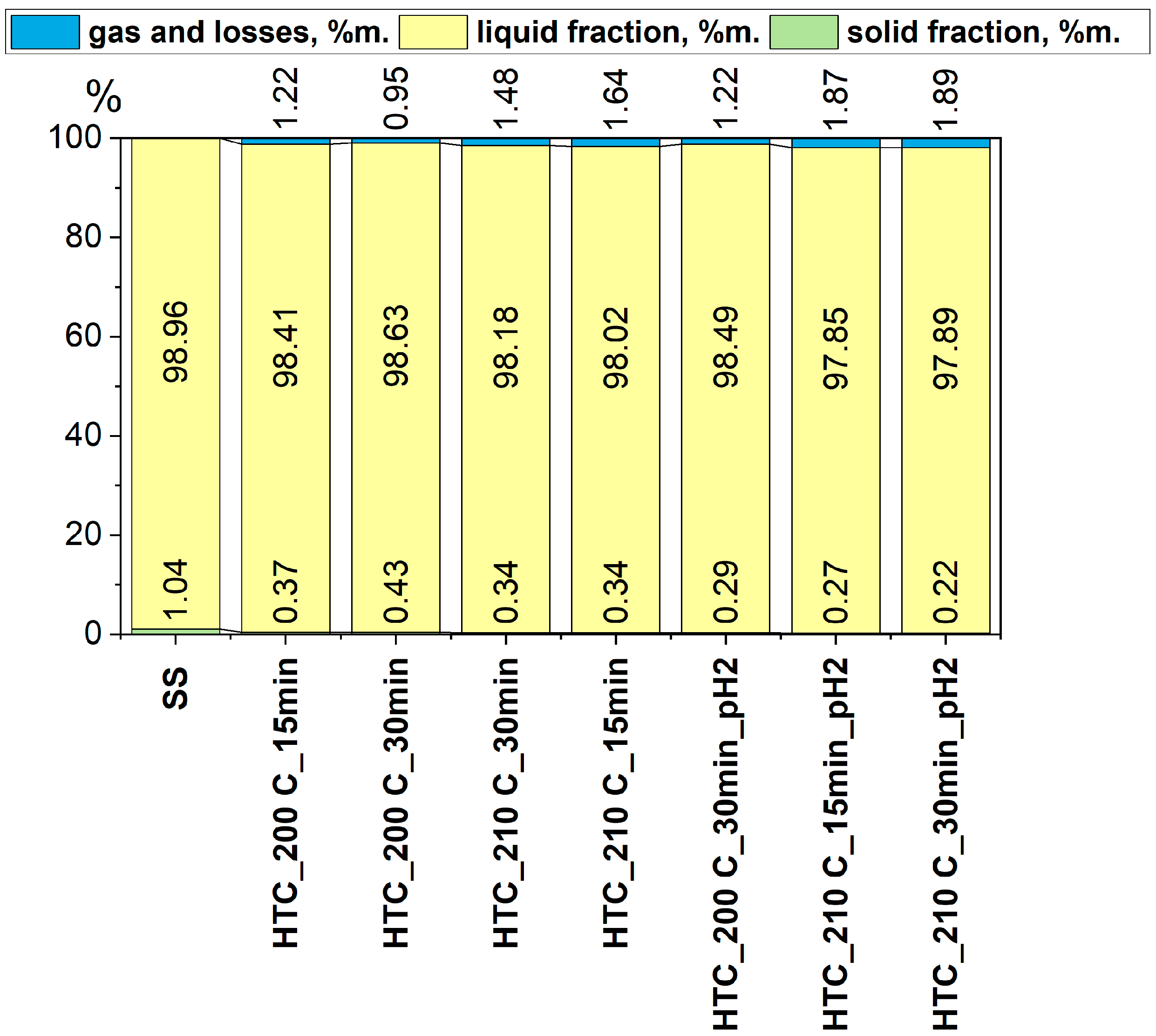
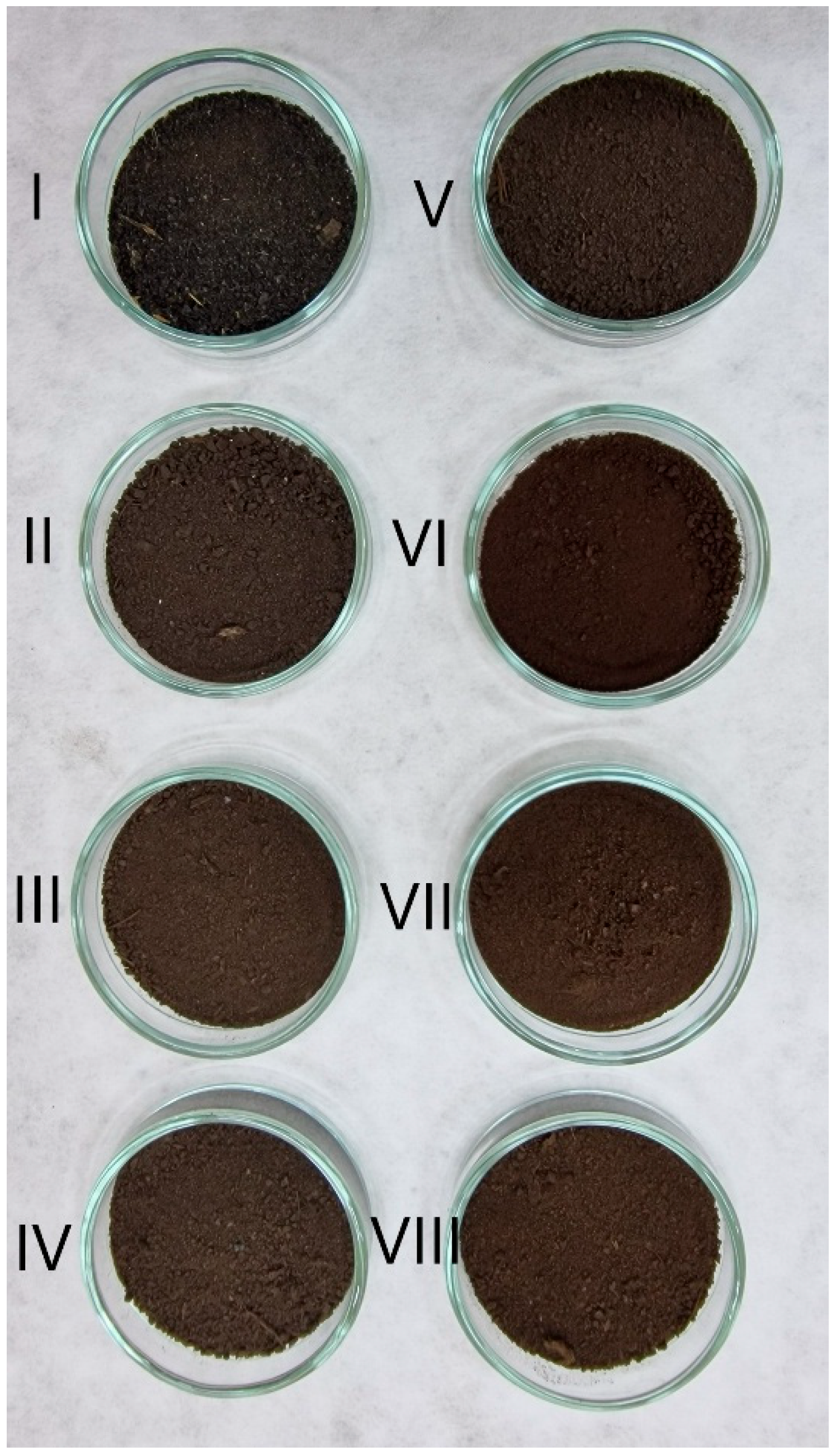
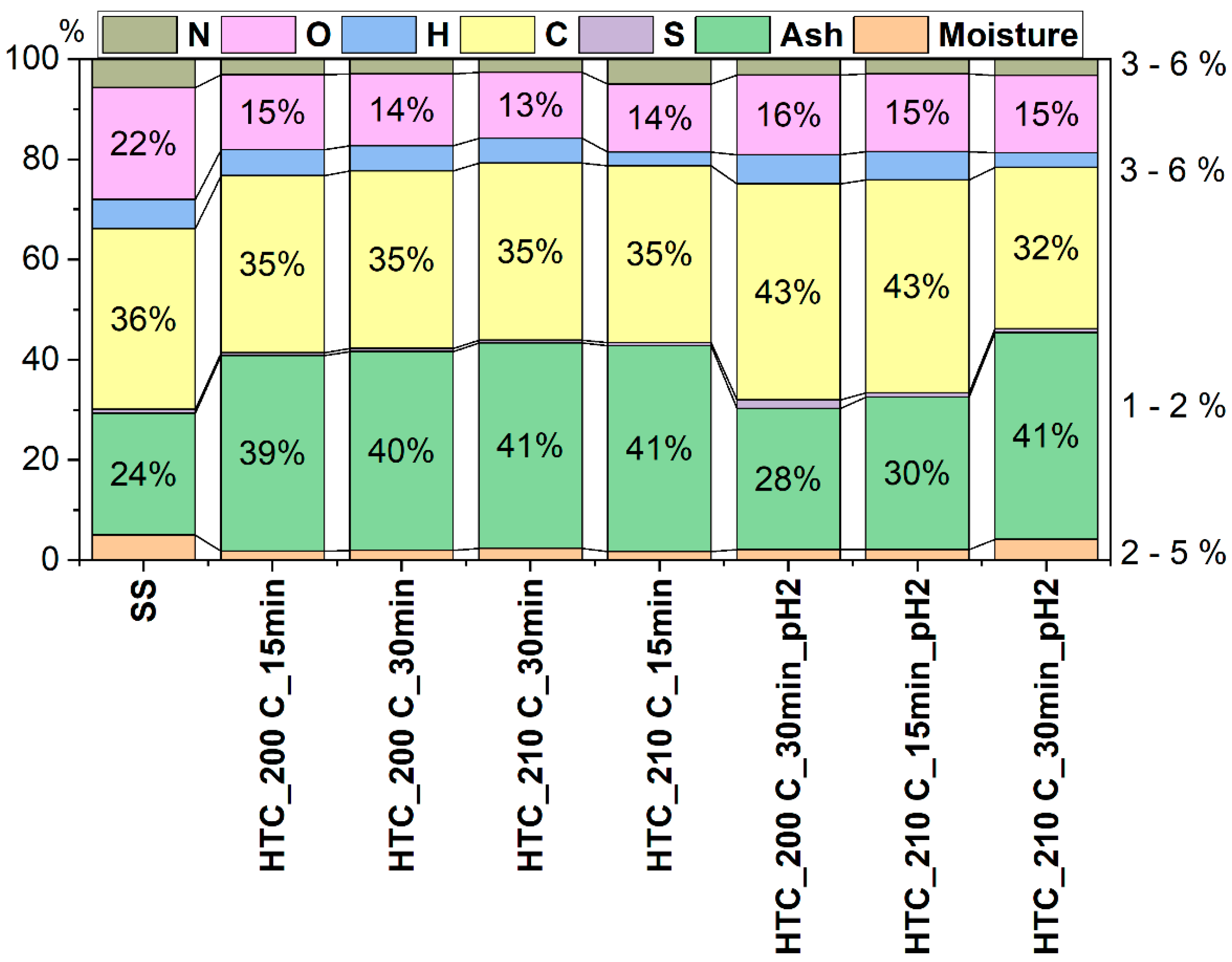

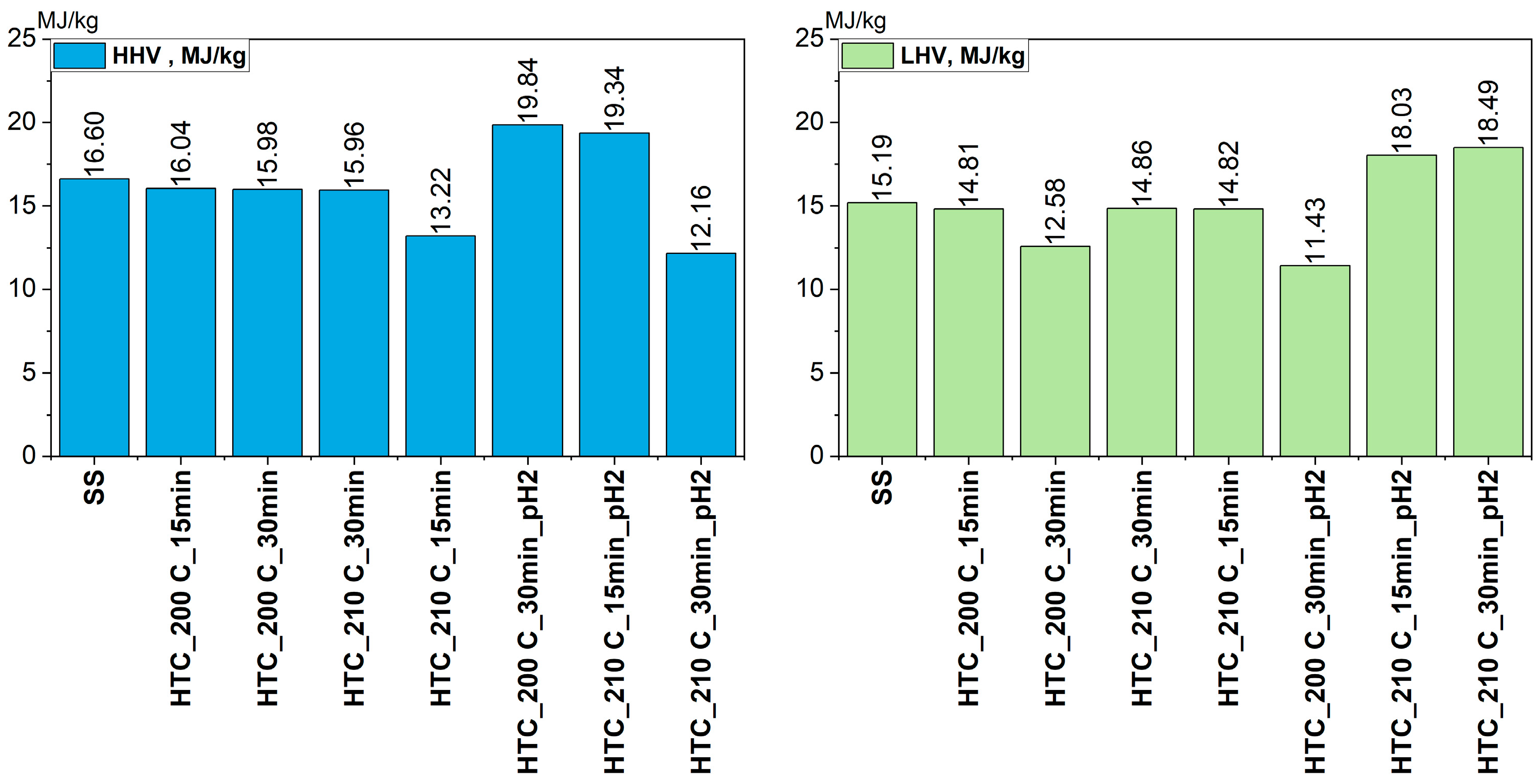

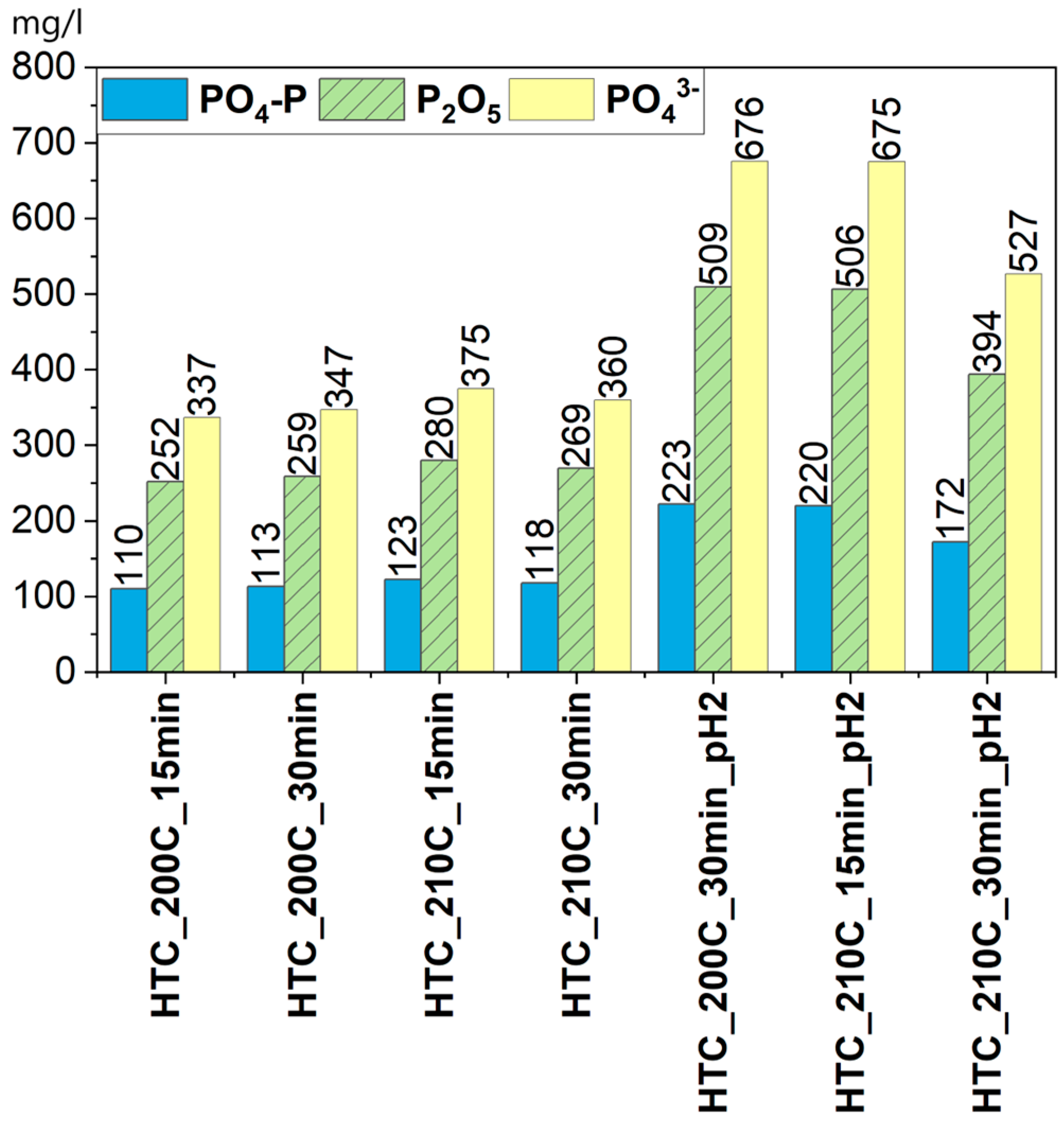
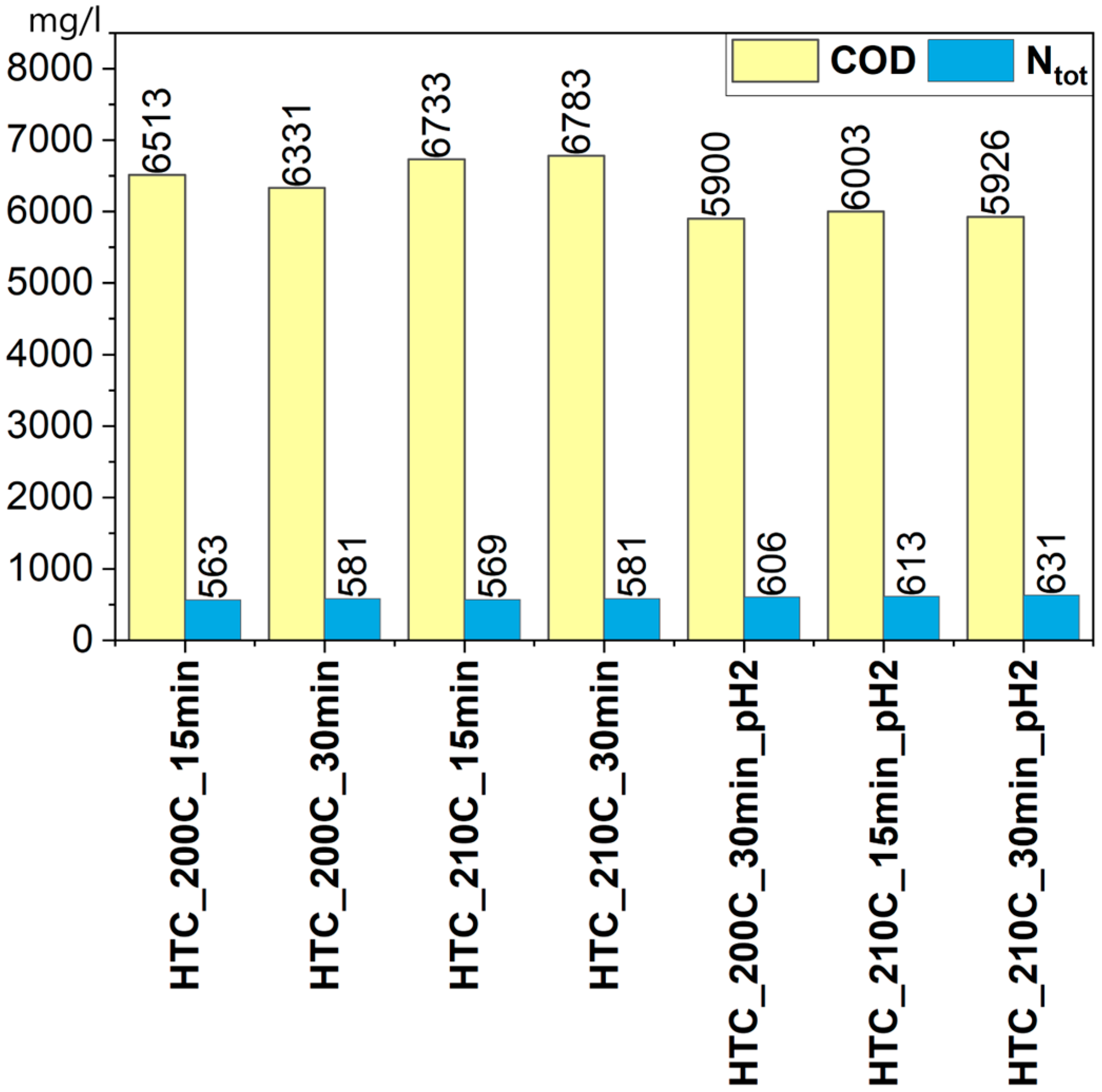

| Parameter | SS |
|---|---|
| K, mg/L | 63.0 |
| P, mg/L | 145 |
| Cr, mg/L | 0.160 |
| Cu, mg/L | 2.00 |
| Cd, mg/L | 0.0166 |
| Ni, mg/L | 0.205 |
| Pb, mg/L | 0.281 |
| Zn, mg/L | 11.0 |
| Hg, mg/L | <0.000100 |
| Ntot, mg/L | 737 |
| P-PO4, mg/L | >16.3 |
| PO4, mg/L | >50.0 |
| Loss on ignition, mg/L | 8555 |
| Sample | C:N | |
|---|---|---|
| 1. | SS Smolnica | 6.4 |
| 2. | HTC_210C_30min | 13.6 |
| 3. | HTC_210C_15min | 7.2 |
| 4. | HTC_200C_15min | 11.5 |
| 5. | HTC_200C_30min_1 | 12.0 |
| 6. | HTC_210C_30min_pH2 | 10.0 |
| 7. | HTC_210C_15min_pH2 | 14.6 |
| 8. | HTC_200C_30min_pH2 | 13.6 |
Disclaimer/Publisher’s Note: The statements, opinions and data contained in all publications are solely those of the individual author(s) and contributor(s) and not of MDPI and/or the editor(s). MDPI and/or the editor(s) disclaim responsibility for any injury to people or property resulting from any ideas, methods, instructions or products referred to in the content. |
© 2025 by the authors. Licensee MDPI, Basel, Switzerland. This article is an open access article distributed under the terms and conditions of the Creative Commons Attribution (CC BY) license (https://creativecommons.org/licenses/by/4.0/).
Share and Cite
Szkadłubowicz, K.; Mikusińska, J.; Pozarlik, A.; Wilk, M. Hydrothermal Treatment of Sewage Sludge Under Different Process Conditions with a Focus on Energy Properties and Resource Recovery. Energies 2025, 18, 6071. https://doi.org/10.3390/en18226071
Szkadłubowicz K, Mikusińska J, Pozarlik A, Wilk M. Hydrothermal Treatment of Sewage Sludge Under Different Process Conditions with a Focus on Energy Properties and Resource Recovery. Energies. 2025; 18(22):6071. https://doi.org/10.3390/en18226071
Chicago/Turabian StyleSzkadłubowicz, Klaudia, Joanna Mikusińska, Artur Pozarlik, and Małgorzata Wilk. 2025. "Hydrothermal Treatment of Sewage Sludge Under Different Process Conditions with a Focus on Energy Properties and Resource Recovery" Energies 18, no. 22: 6071. https://doi.org/10.3390/en18226071
APA StyleSzkadłubowicz, K., Mikusińska, J., Pozarlik, A., & Wilk, M. (2025). Hydrothermal Treatment of Sewage Sludge Under Different Process Conditions with a Focus on Energy Properties and Resource Recovery. Energies, 18(22), 6071. https://doi.org/10.3390/en18226071








